What is the pack line defense in basketball
The pack line defense is a basketball defensive strategy as well as a variation of man to man defense that implements on-ball defensive pressure and off-ball actions in which defenders will either sag into the pack line or deny passing lanes to limit or prevent offensive scoring opportunities.
Furthermore, the pack line defense was initially developed by Dick Bennett and it has also been utilized by his son, Tony Bennett as well as a variety of other coaches in recent years.
What is the pack line itself
The pack line is basically an imaginary line covering the perimeter areas inside of the three-point line about 16 feet from the basket.
Essentially, any four off-ball defenders that are not currently guarding the player with the ball should be within that pack line standing in the gaps between the top/wing and the wing/corner.
The only exception to that rule is if an offensive player ends their dribble, a concept known as a dead dribble within the pack line defense.
If that occurs, then defenders that are one pass away near the perimeter can possibly come out of the pack line to deny their respective assignments from easily receiving the ball.
Why is the pack line defense a potentially effective strategy
The pack line defense is a potentially effective strategy because it limits dribble penetration, hinders scoring opportunities, especially near the basket, and it influences the offensive team into settling for jumps shots from the mid-range or beyond the three-point line.
Limit dribble penetration
Each defender within the pack line defense will either pressure the player with the ball as an on-ball defender or sag into the gaps/pockets of the possible driving lanes as an off-ball defender.
As a result of that, an offensive player with the ball will have difficulties easily navigating through the entire defense to ultimately get to the rim.
As an example, let’s say the on-ball defender that is currently guarding the offensive player is able to use a proper defensive stance and sliding movement to stay in front of the offensive player without fouling.
This essentially means that the offensive player with the ball cannot easily dribble towards the basket due to the resistance of the on-ball defender.
However, let’s also say in certain instances, the offensive player with the ball is able to get by the on-ball defender, particularly towards the middle of the lane with initial dribble penetration.
If that were to occur, then the dribble penetration of that same offensive player would eventually be hindered or completely stopped by the one of the other four pack line defenders which provide secondary help defense near the gaps of the pack line.
Hinder scoring opportunities, especially near the basket
Since the pack line defense, at least in theory, is designed to limit or prevent dribble penetration, this basically means that an offensive player in current possession of the ball should not be able to easily score by dribbling the ball to the rim.
In addition to that, because off-ball defenders sag away from their respective assignments towards the lane, this should potentially take away easy scoring opportunities of off-ball offensive players that might cut to the rim such as with the backdoor cut.
In other words, if an offensive player that is playing off the ball cuts to the basket, there should be at least one off-ball pack line defender nearby to slow down or completely take away that offensive player’s cut before they even have a chance to receive the ball.
Furthermore, if the offensive team prefers to get the ball into the low post area and score near the basket in that manner, then the pack line defense has certain rules to mitigate or totally eradicate that type of scoring option.
That is, if the low post player has not yet received the ball, then the adjacent pack line defender guarding that low post player can front the post as a method of discouraging the post entry pass, especially from the wing areas.
On the other hand, if the low post player receives the ball, then the next typical defensive action is to utilize a double team, typically from a weak side help defender to influence the low post player with the ball to pass it back near the perimeter areas of the court.
Influences jump shots near the perimeter
If the pack line defense seeks to limit dribble penetration, especially into the lane, as well as additional scoring options near the basket, then the only other viable option is to defeat it with jump shots, particularly from three-point range.
However, a problem arises if the offensive team has players with below average three-point shooting abilities.
That is, if the sagging pack line defender one pass away is not able to recover and properly contest the jump shot, this will not be much of an issue if the offensive player taking that shot is a non-shooter, particularly from three-point range.
On the other hand, if sagging pack line defenders are able to contest jump shots near the perimeter areas, even on a late closeout, this could further diminish shooting percentages of the offensive team with below average shooters.
What is a disadvantage of the pack line defense
One particular disadvantage of the pack line defense is that it might not be as effective against offensive teams with multiple above-average three-point shooters.
As mentioned previously, the off-ball defenders sag into the pack line near the exterior of the free throw lane, primarily to prevent dribble penetration.
However, if an offensive player with the ball dribbles toward the pack line as a decoy, that same player could easily execute the kick pass to an adjacent teammate one pass away.
From that point, the sagging off-ball defender most likely would not have enough time to recover to their assignment with a proper defensive closeout.
If that were to occur, the offensive player which received the ball via the kick pass would probably be able to take an uncontested jump shot.
Furthermore, even if the pack line defender is able to execute a late closeout and get a hand up to contest the shot, this may not be very bothersome to a great three-point shooter.
What are general principles of the pack line defense
If the ball is live
If the ball is live which means it has not yet been dribble or it is currently being dribbled by an offensive player, then the on-ball defender guarding that offensive player should apply as much ball pressure as possible without fouling.
Furthermore, at the same time, the other four off ball defenders should stay within the pack line by sagging off of their respective assignments that will generally be one or more passes away from them.
If the ball is dead
If the ball is dead because the player with the ball ended their dribble, then the on-ball defender should continue to apply ball pressure and have active hands without fouling.
In addition, the active hands of the on-ball defender could be used to obscure the vision of the offensive player with the ball.
Moreover, in certain situations, the on-ball defender might be able to deflect an attempted pass by the offensive player with the ball which could lead to a turnover
Simultaneously, adjacent off-ball defenders can move outside of the pack line to execute denial defense against their assignments that are one pass away from the offensive player with the ball.
Off-ball defenders should remember ball, you, man
Each off-ball defender should keep in mind the defensive concept of ball, you, man.
That is to say, each off-ball defender should always know where the ball and their respective assignment (i.e. their man) is at all times.
On-ball defenders should execute a good closeout
Each defensive player that becomes an on-ball defender should try to properly perform the closeout with high hands and short, choppy steps.
In addition to that, any closeout defender should always try to contest jump shots whenever possible.
Keep the ball away from the lane but also, away from the baseline
Standard man to man defense typically dictates keeping the ball out of the middle in general and preferably on one side of the floor if possible.
However, the pack line defense does not usually emphasize its defensive concept in that manner.
Instead, the pack line defense first prefers that the on-ball defender completely prevents any dribble penetration altogether with solid on-ball defense.
Yet, at the same time, if an offensive player with the ball does happen to get a little bit of dribble penetration, the second preference is to influence the ball towards the pack line and by extension, a secondary help defender.
If that occurs, the help defender within the pack line could either prevent additional dribble penetration or influence the offensive player into taking a low quality, contested jump shot.
Also, the secondary help defender could also simply cause the offensive player to pass the ball to another teammate near the perimeter and away from the basket, which is a benefit to the defensive team.
In addition to this, pack line on-ball defenders should try to reduce dribble penetration towards the baseline as much as possible.
Basically, in the pack line defense, if an offensive player gets baseline dribble penetration, then an adjacent pack line defender near the basket would most certainly have to rotate over to help, which in turn would trigger the help the helper concept.
That is to say, the pack line defender that is helping to stop the baseline penetration would need help themselves from one of the other pack line defenders, which would have to slide into the lane to protect the basket.
Once again, in standard man to man defense, help the helper is not much of an issue but in the pack line defense, the additional rotations would not only result in potential defensive breakdowns, but it would also defeat the main objective of the pack line defense.
In other words, the general purpose of the pack line defense is to keep the off-ball defenders near the gaps of the pack line to limit or prevent dribble penetration or supplementary off-ball offensive actions.
However, if off-ball defenders have to execute multiple rotations, then those gaps would more than likely become exposed. That, in turn, would probably lead to defensive breakdowns as well as scoring opportunities for the offensive team.
Defending the low post
If the ball is not yet in the low post, then the pack line defender that is guarding the offensive low post player should front the post, typically on the high side, to deny an easy post entry pass.
Furthermore, if the ball does get into the post, then the pack line typically prefers to get the ball out of the post as soon as possible.
Therefore, the defensive team could execute a double team in which the primary defender gets help from a weak side secondary defender.
Alternatively, it is also feasible to execute a double team with a secondary defender on the same side of the ball, that is the strong side.
However, the alternative double team should generally only occur if the secondary defender’s assignment is a below average three-point shooter.
It is because in that case, the secondary defender would only be one pass away from their assignment, which could lead to an uncontested jump shot, which is bad for the defense if that shooter is above average.
Defending in transition
Prior to transition defense, when the offensive team takes a field goal attempt, it is generally preferred that only one or two players go for offensive rebounds.
Afterwards, during transition defense, one of the defenders should always sprint back to protect the basket while the other defenders try to match up with opposing offensive players before reaching half court.
Also, it should be noted that during transition defense, it is not an absolute requirement that each defender matches up with an offensive player that they were guarding on a previous offensive possession.
However, it is preferred that defensive players try to match up with offensive players of similar size and attributes whenever possible to mitigate the effects of defensive mismatches.
Following that, if the offensive team does not score during transition offense but instead, flows into their half court sets or motion offense, then the defensive team could segue into the pack line defense concepts as well.
What are simple diagram examples of the pack line defense
Example 1
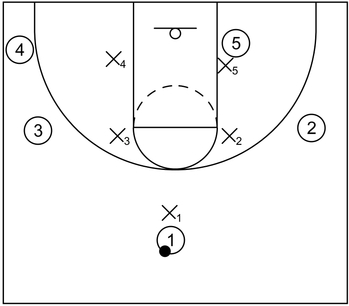
This is an example of the pack line defense when the ball is live at the top. That is to say, 1 is currently dribbling the ball and has not ended the dribble. To begin, X1 applies on-ball pressure against 1.
As that occurs, the other four defenders are inside of the pack line. That is, X2 and X3 are currently near the high post elbows while X4 and X5 are currently near the low post areas.
Additionally, X5 could also execute a three quarter front or total low post front on the high side of 5, near the basket.
Example 2
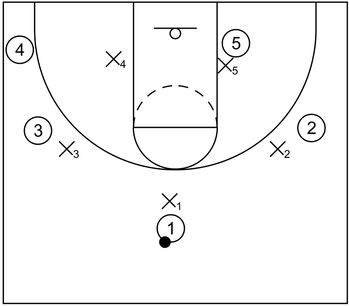
This is an example of the pack line defense when the ball is dead at the top. That is to say, 1 has completely ended the dribble.
When that occurs, X1 applies on-ball pressure while X2 and X3 perform denial defense against 2 and 3 one pass away.
Also, X5 continues to front the low post while X4 remains near the left side low post area for the time being.
Example 3
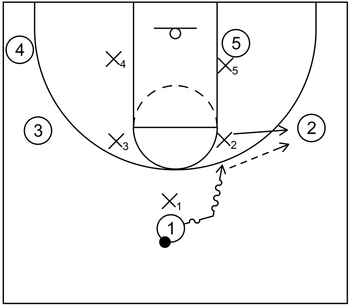
This is an example of the pack line defense when 1 is able to get by X1 and then attempt to dribble into the lane. When that occurs, X2 prevents further penetration by standing in the gap between the top and the wing.
As a result, 2 receives the ball from 1 and then, X2 has to swiftly try to closeout to prevent any further dribble penetration and/or contest a potential jump shot.
Example 4
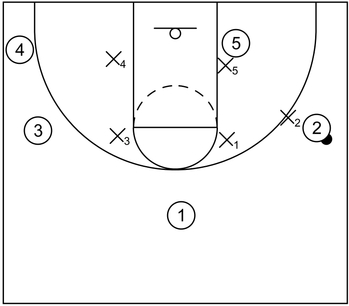
This is an example of the pack line defense when the ball is live on the wing. When that happens, X2 applies on-ball pressure. Moreover, since the ball is on the right side wing, X2 denies the baseline side by influencing 2 towards the left.
That is to say, X2 puts pressure on the ball but at the same time, 2 is encouraged to dribble towards the top or the middle where the pack line defender, X1 can provide help and support if necessary.
X5 continues to front the post on the high side while X3 and X4 are in help formations on the weak side.
Example 5
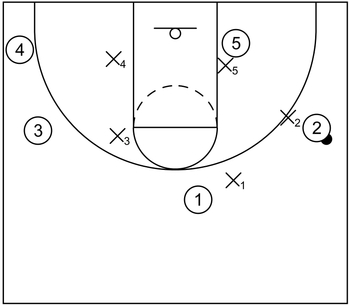
This is an example of the pack line defense when the ball is dead on the wing. When that occurs, X2 applies on-ball pressure as before. However, this time, X1 can deny the pass back to 1 because 2 ended the dribble action.
X5 continues to front the post while X3 and X5 are in help spots on the weak side.
Example 6
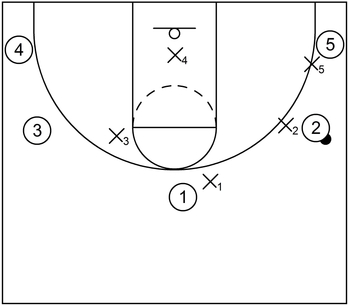
This is another example of the pack line defense when the ball is dead on the wing. However, this time, 5 is near the right side corner as opposed to the right side low post area.
This also happens to create a 5 out formation for the offensive team. From that point, both X1 and X5 can deny the ball in the passing lane of 1 and 5 respectively.
Furthermore, X4 could temporarily slide in the lane to provide additional basket protection in the event that 4 or 5 cut to the basket.
Example 7
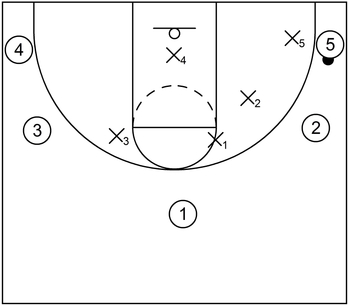
This is an example of the pack line defense when the ball is live in the corner. When that occurs, X5 applies on-ball pressure against 5. At the same time, X5 denies the baseline but influences 5 to dribble towards the help defender, X2.
Furthermore, X2 sags away from 2 and stands in the gap between the wing and the corner. This allows X2 to help on possible dribble penetration by 5 and it also prevents an easy backdoor cut by 2.
X1 is also in help position near the right side high post elbow. So, if 1 attempts to cut, then X1 can cut off that pathway.
At the same time, if 2 receives the ball from 5 but then attempts to dribble towards the lane, X1 can also mitigate that dribble penetration as well.
X3 and X4 are in help defense on the weak side. Furthermore, X4 can actually slide into the lane to provide extra basket protection as well.
Example 8
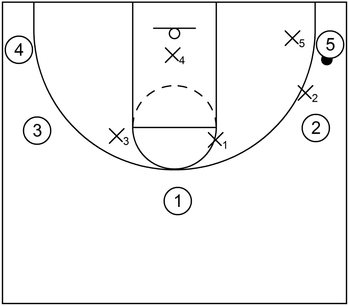
This is an example of the pack line defense when the ball is dead in the corner. When that occurs, X5 applies on-ball pressure as before against 5. However, this time, X2 denies the pass back to the adjacent wing.
At the same time, X1, X3, and X4 are ready to provide help defense, particularly by watching for cuts to the basket by off-ball offensive players. Moreover, X4 can slide into the lane to protect the basket as before.
Example 9
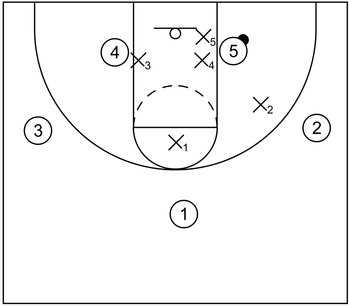
This is an example of the pack line defense when the ball gets into the low post. If that occurs, then X4 could double team the low post alongside X5.
Furthermore, for this case, 4 is near the weak side low post block and could quickly receive the ball from 5.
Therefore, to mitigate or prevent that action from happening, X3 could sink down to take away the possible drop pass from 5.
At the same time, X1 fills the high post near the center of the free throw line, also known as the nail to take away easy cuts to the basket by 1.
This is very similar to the sink and fill concept, most notably utilized as a help defense counter strategy if dribble penetration occurred near the baseline in the standard man to man defense.